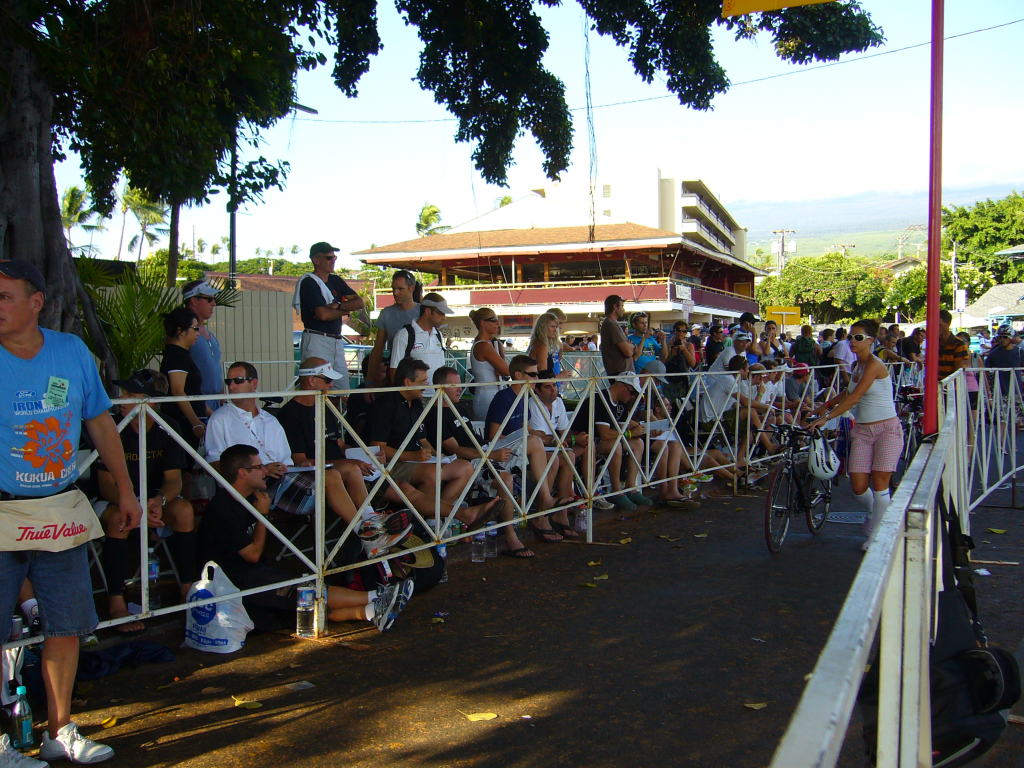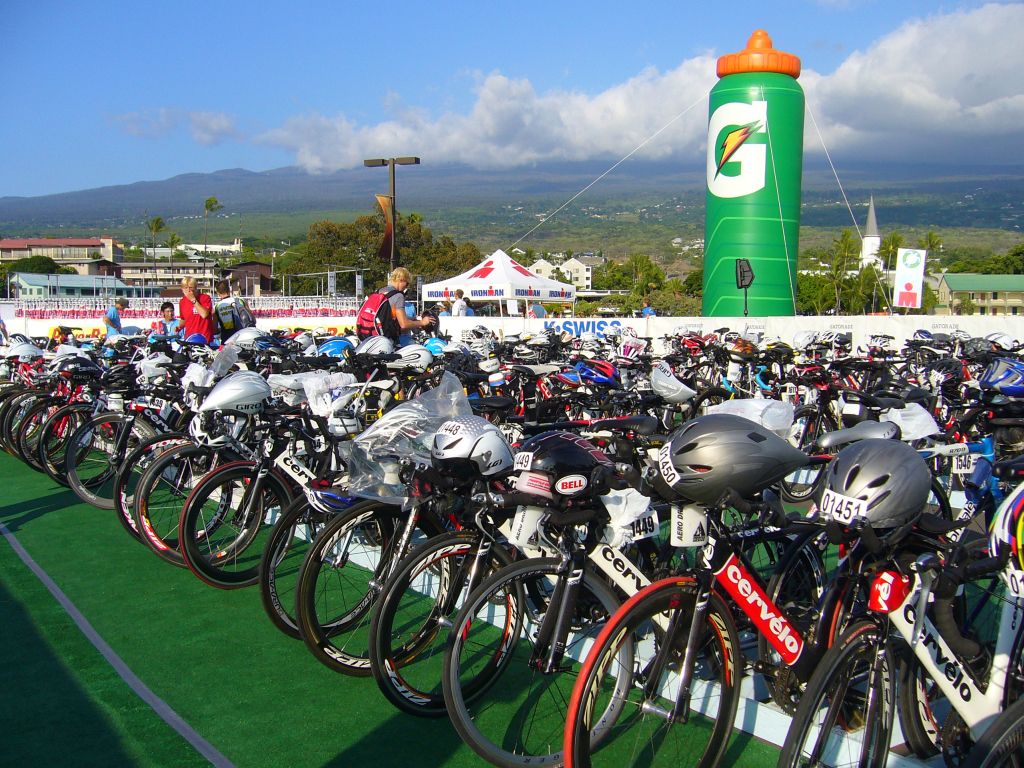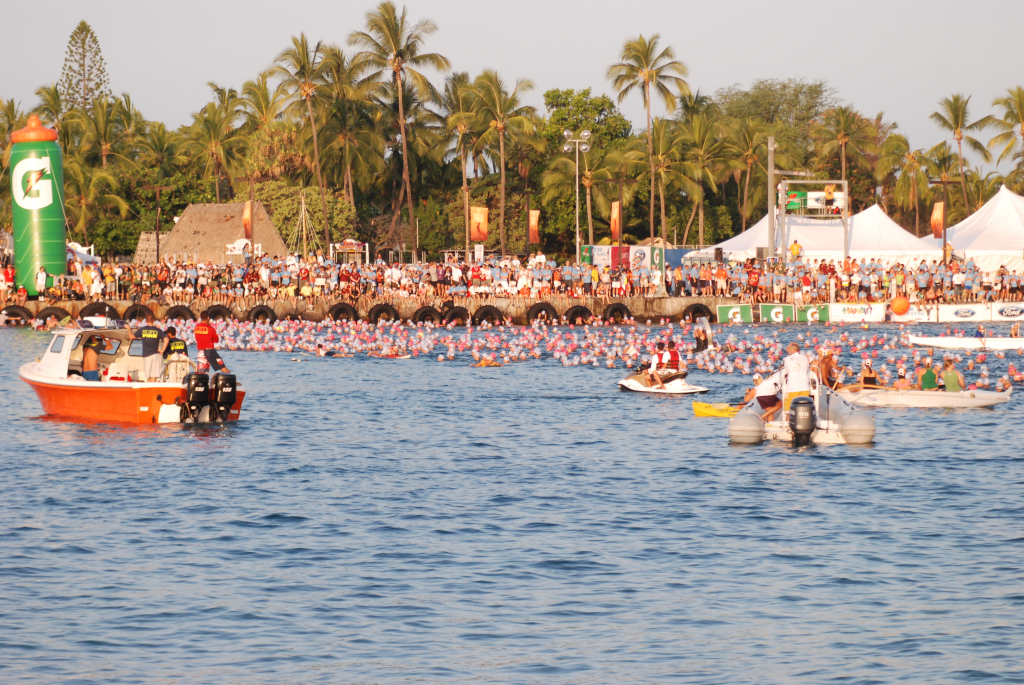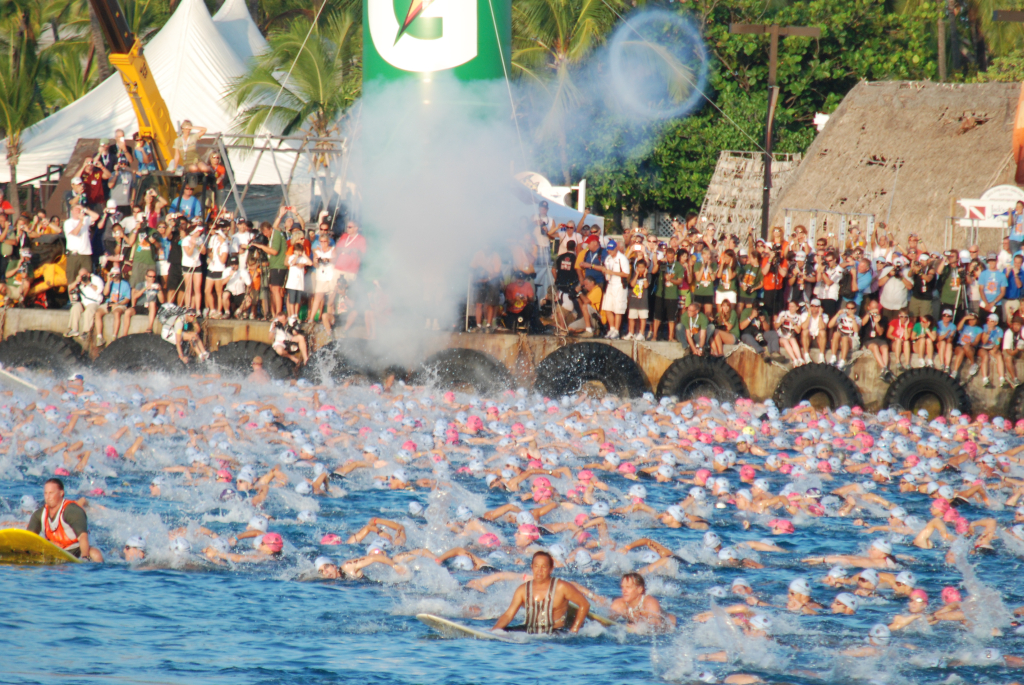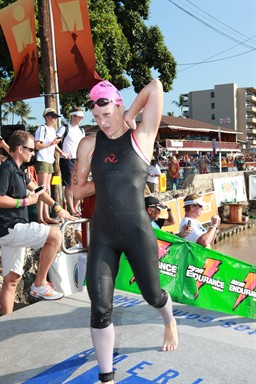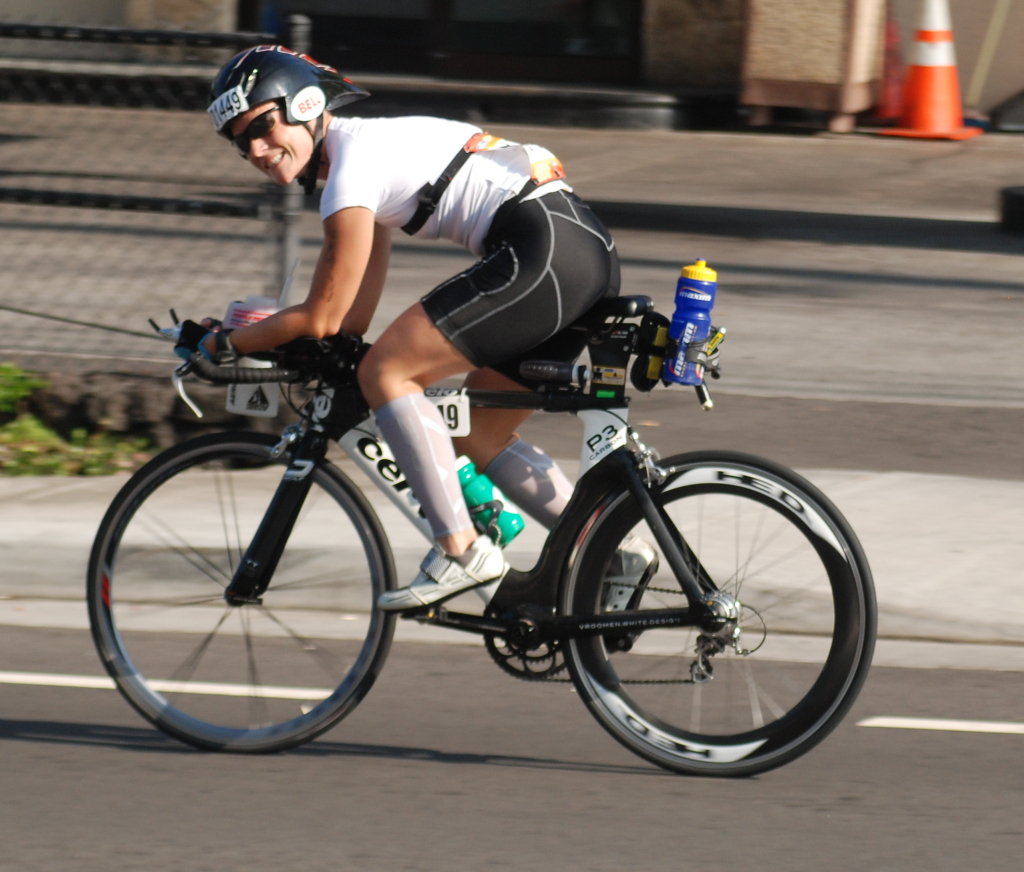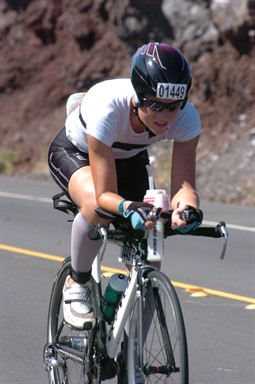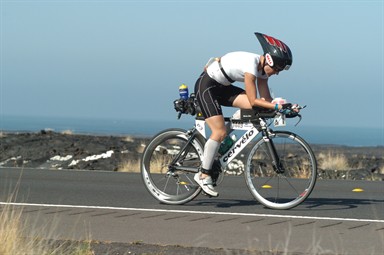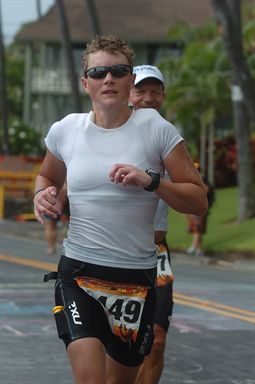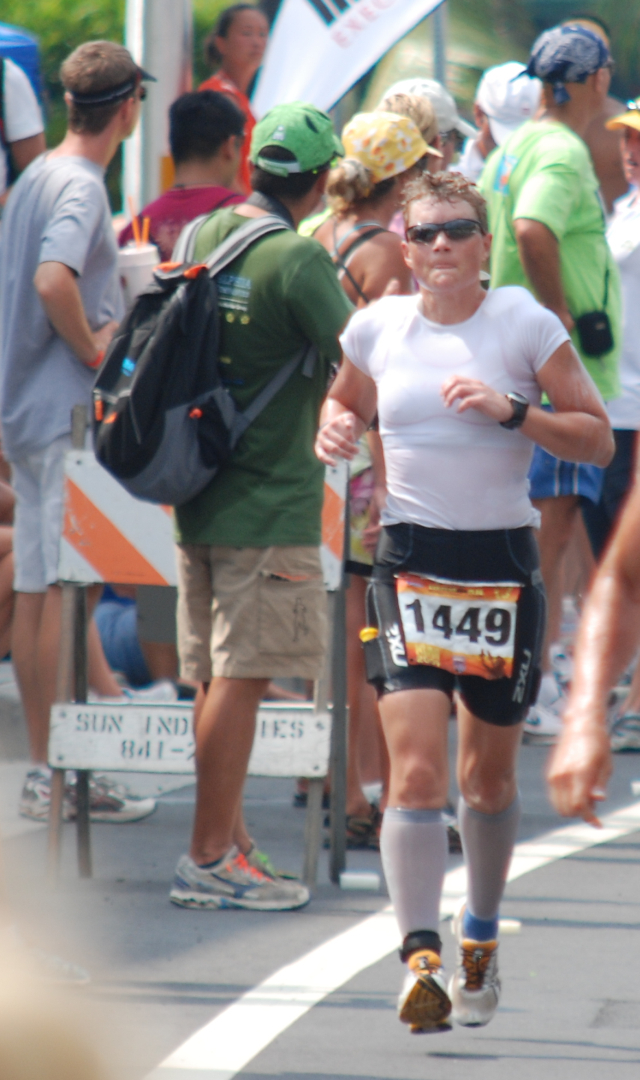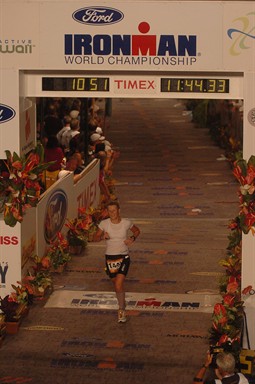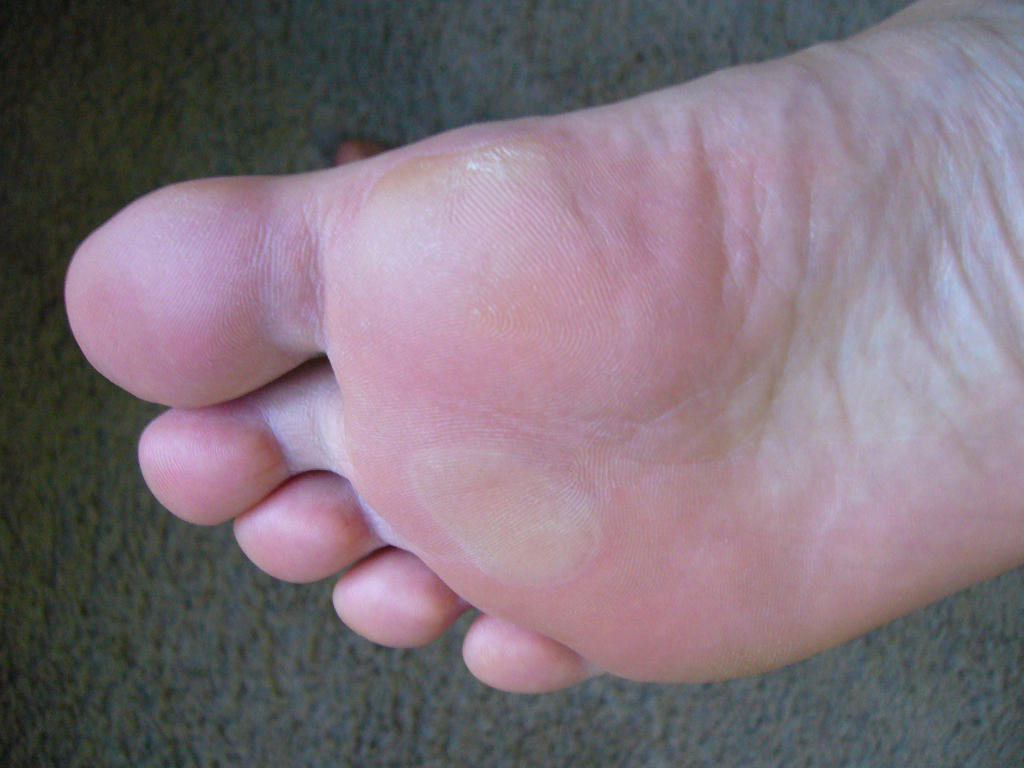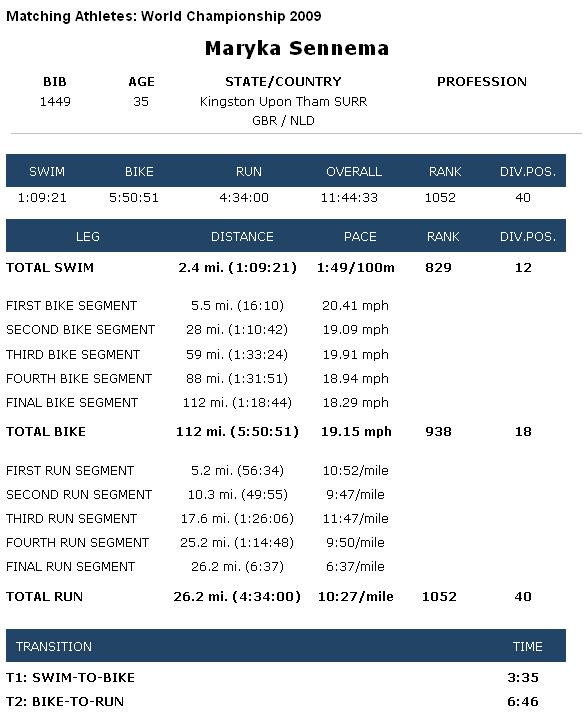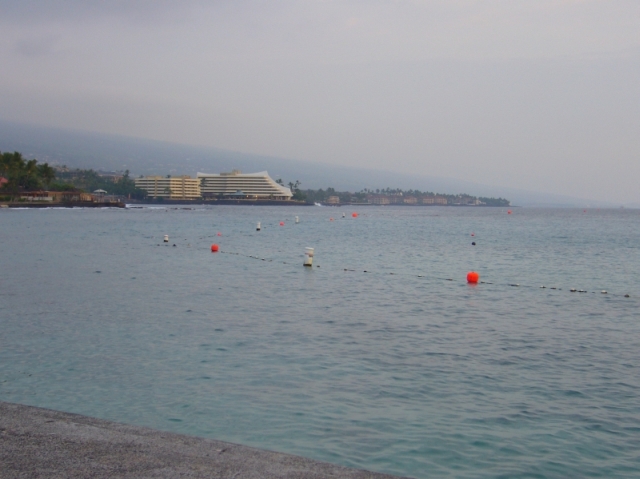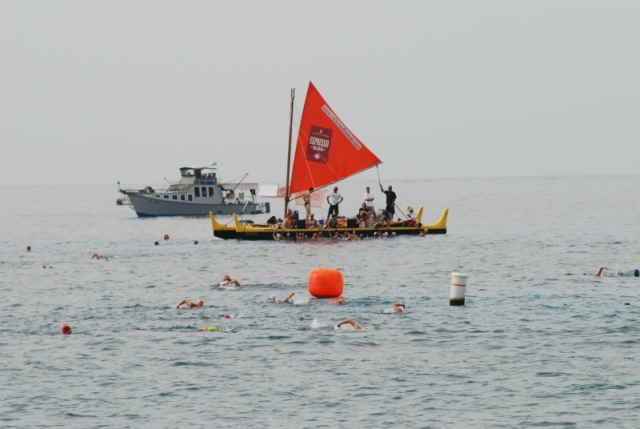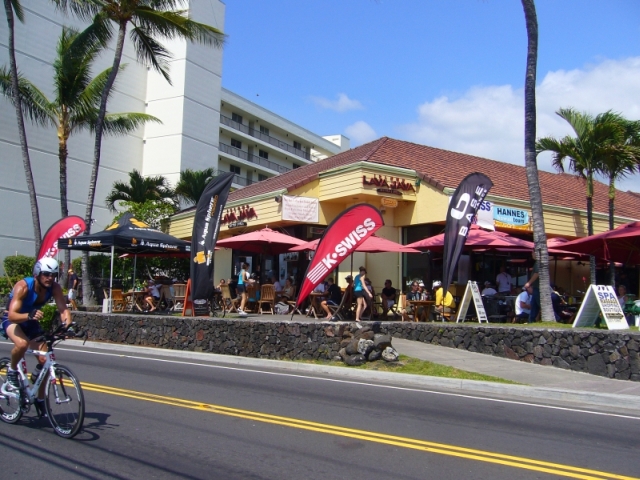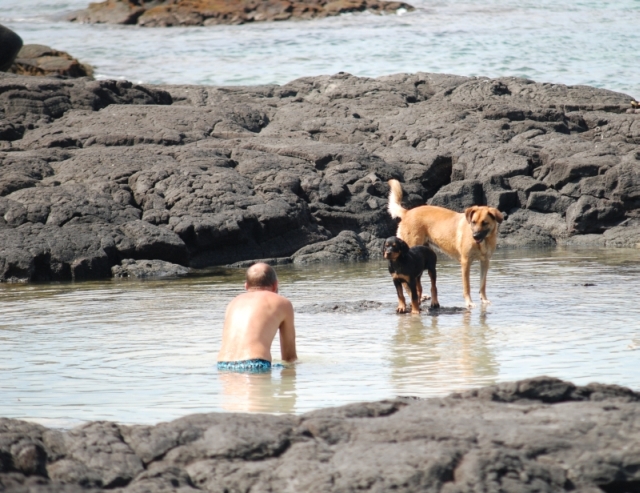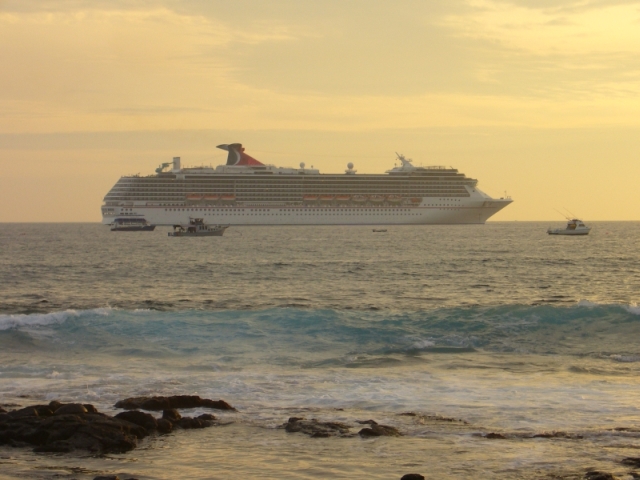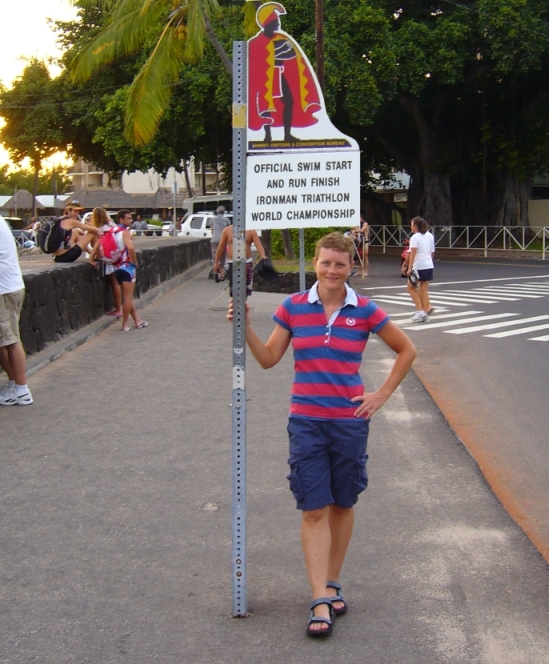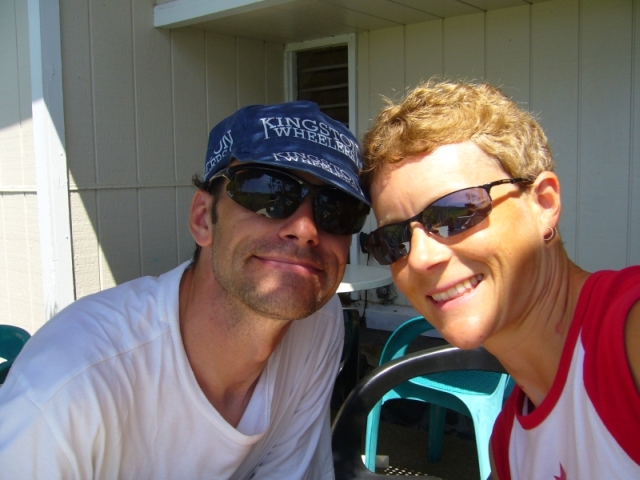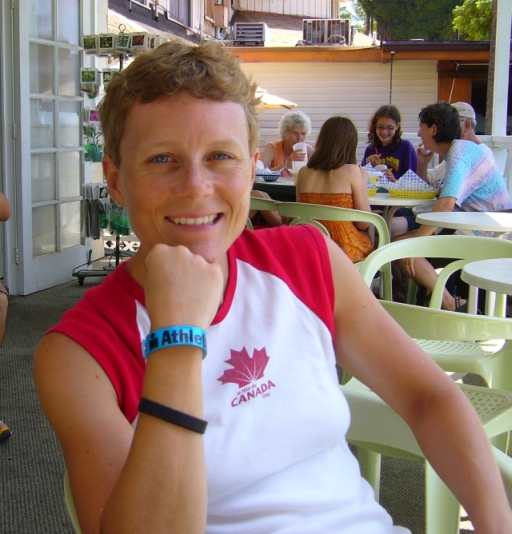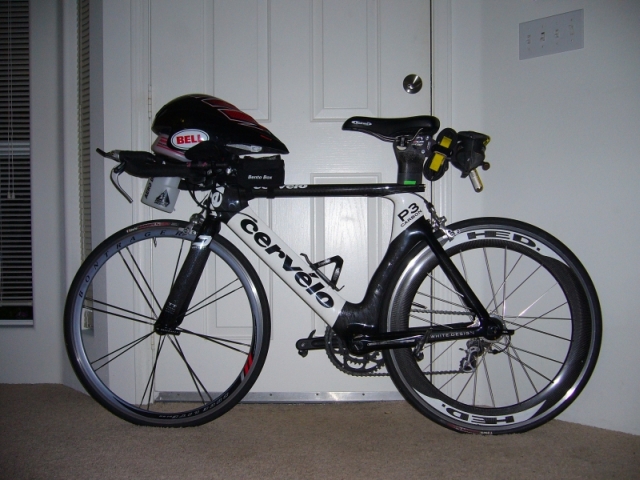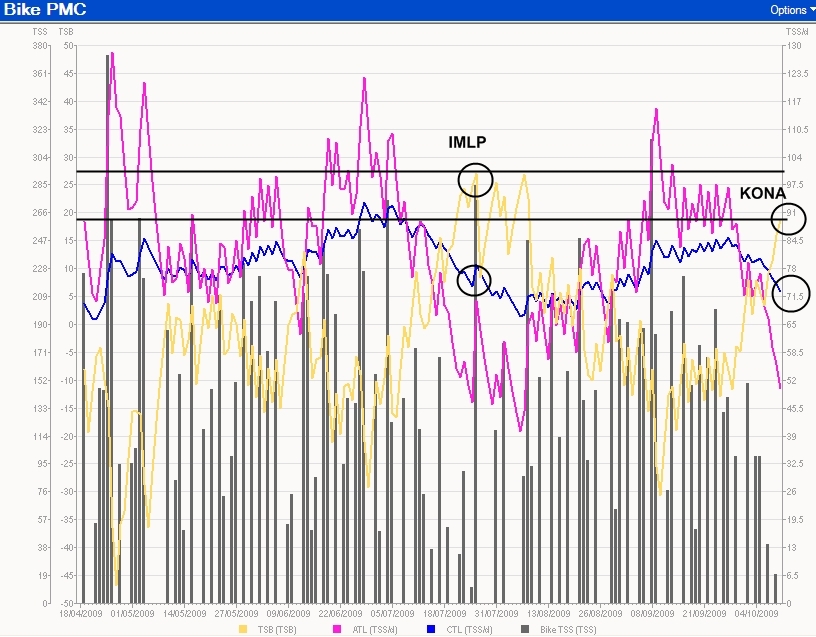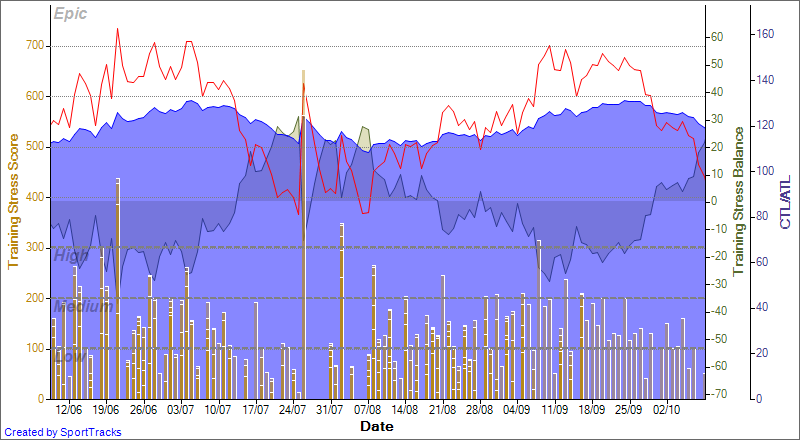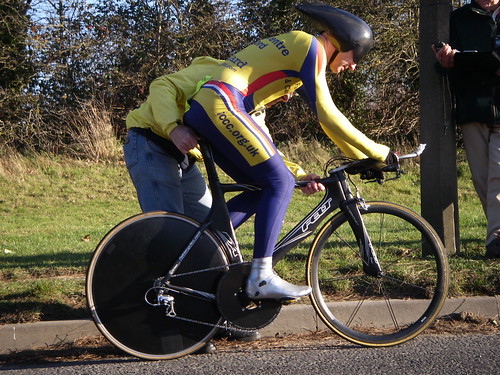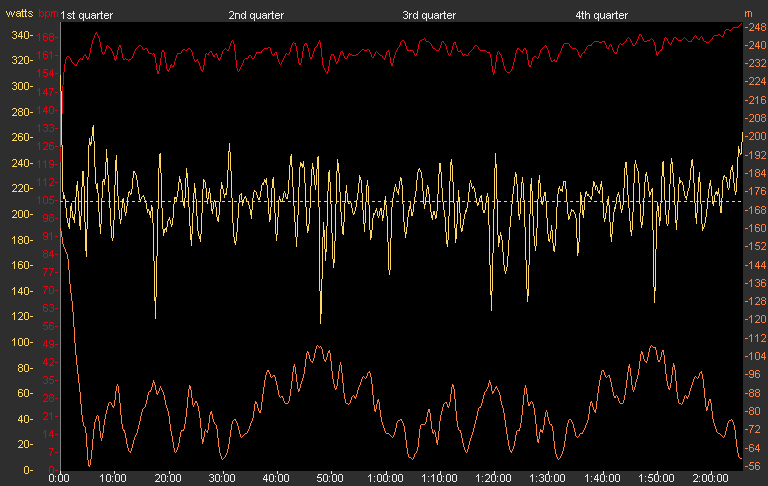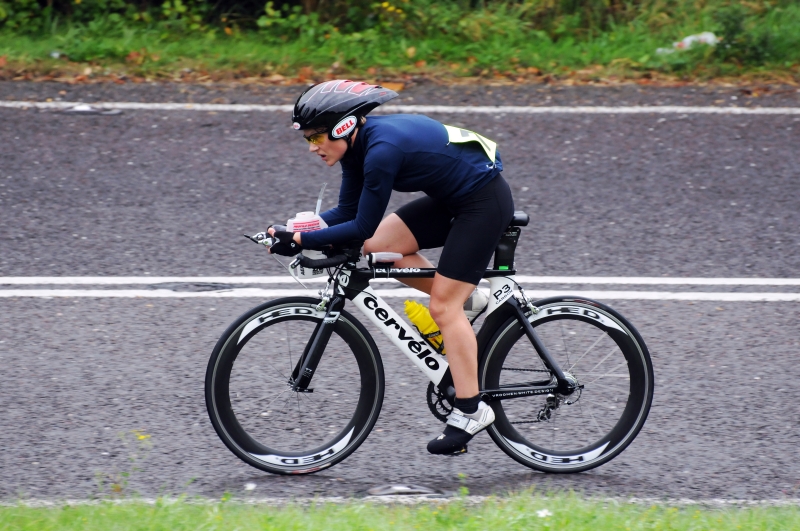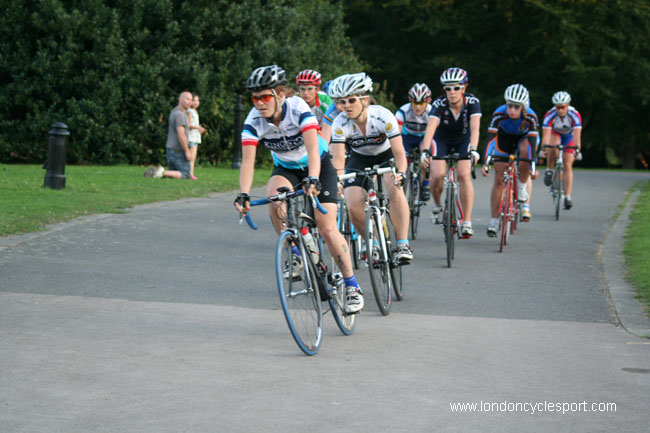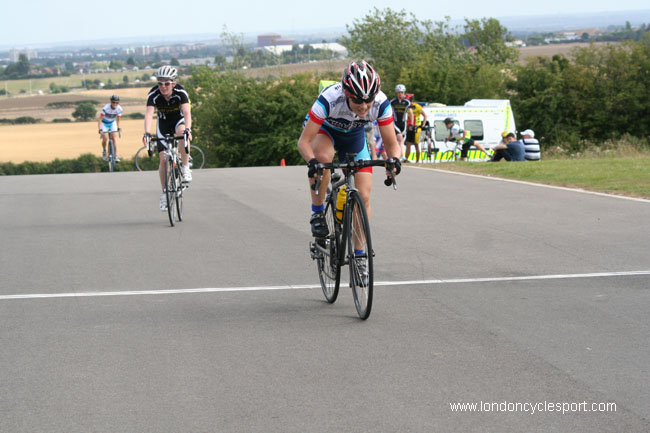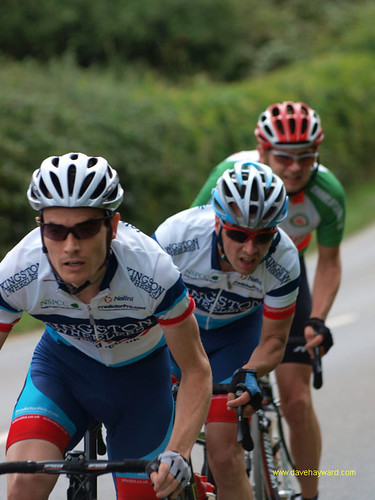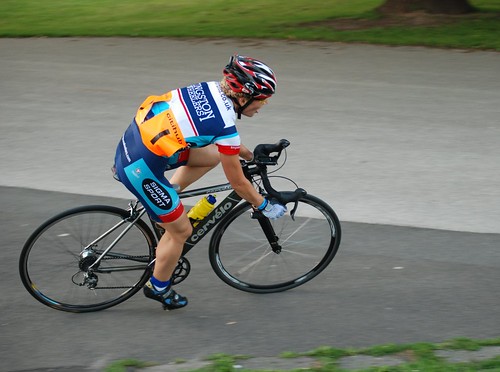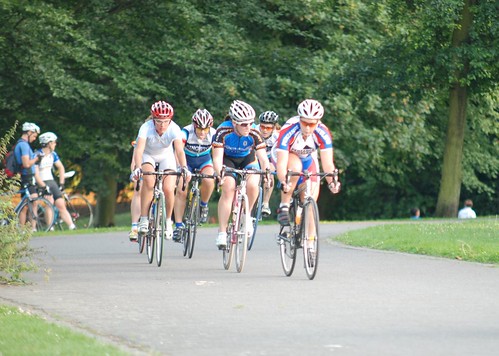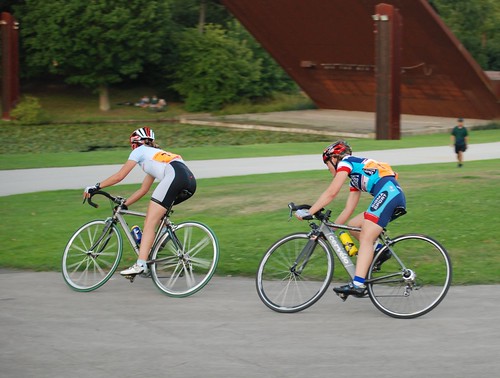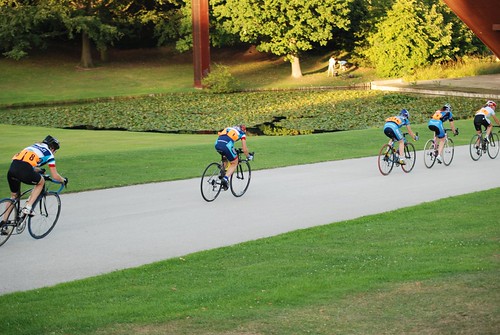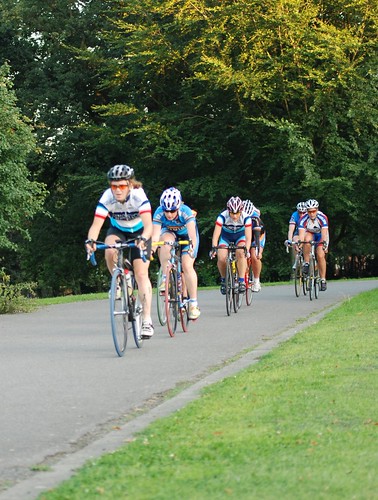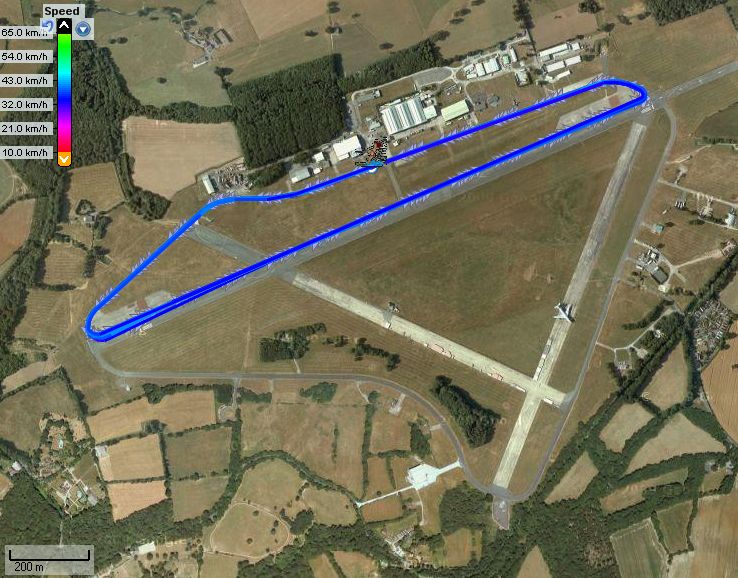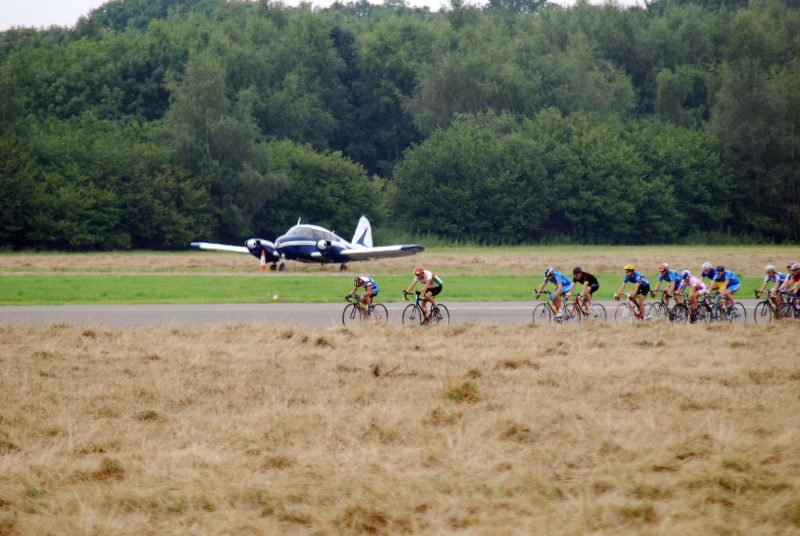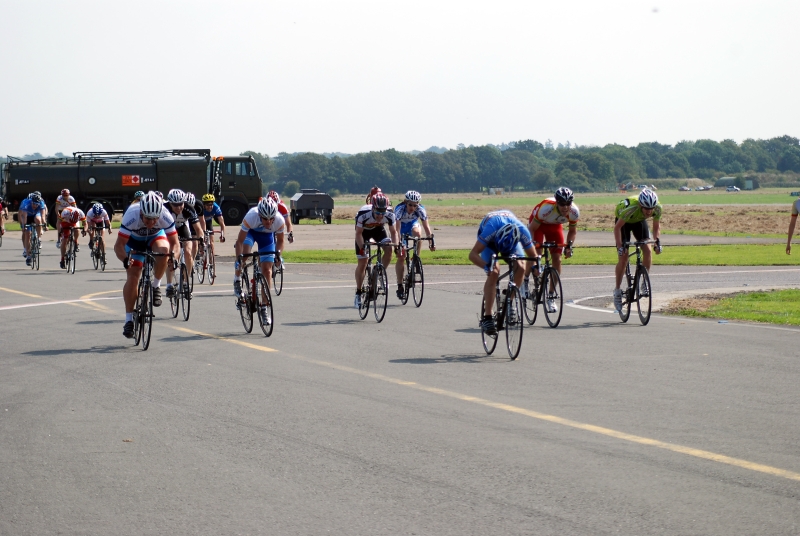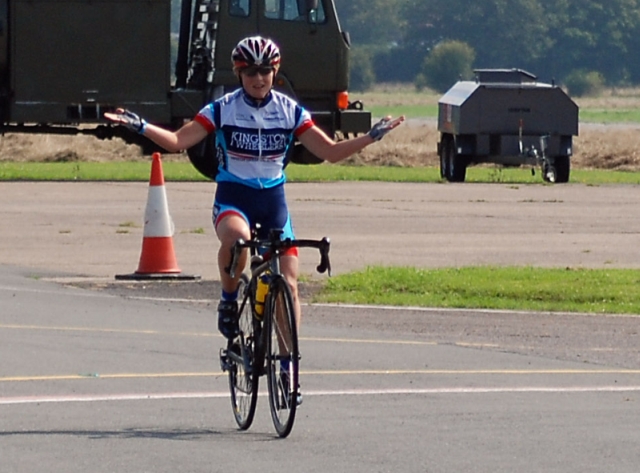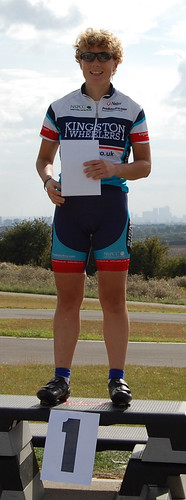Wow, a whole month since I've posted anything. No real excuse other than that I was tapering for and travelling to Ironman Lake Placid, trying to get my head around the race and just generally taking it easy and getting rested. Note to self to get off my arse and post more often from now on! (and shorter posts too, this one is a whopper!)
 The Trophy
The TrophyAnyway, the race. By now, pretty much everyone knows that I achieved what I set out to do and beyond, not only earning a Kona slot but winning my W35-39 age group. The former was never really at risk, but the latter still amazes me. How often do you really get to win something? I can count the number of races I've won since as an adult -- triathlon, running, swimming, cycling -- on one hand. What a privilege and triumph. But I'm getting ahead of myself here... of course every great race has a story, so here's mine.
PrologueWe left the UK on July 14, flew to Boston then picked up the rental car (fully loaded with a bike box (mine), bike bag (Jim's), two large backpacks and two small ones. Thank God for American cars, this would not have worked if we'd been flying and renting a car in Europe!) Drove straight to Ottawa that day, arriving after midnight. My brother and sister-in-law were generous enough to put us up for the week, which meant great food, even better company (my parents and sister came up on the weekend to visit) and lots of downtime to ride around Ottawa. In particular the Gatineau Park is a fabulous place to ride, but I'll save that for another post.
A week later we drove to Lake Placid to get settled into our three-bedroom condo just on the north side of town. We'd lucked into a place with some other folks when one of their friends had been unable to do the race, thanks to a nasty car/bike accident. It turned out to be perfect for us, though, as our housemates were fantastic and a great mix of first-time IM competitors, vets, and supporters. We were close enough to walk to town but far enough to be away from the bustle of the Ironman Show, which can really wear you down if you're immersed in it 24/7.
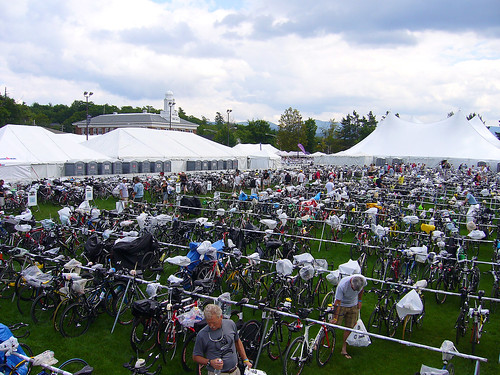 Transition Zone
Transition ZoneI had been feeling a bit under the weather most of the week, just generally tired (despite sleeping quite well) and my stomach was a bit off (though I did avoid eating a lot of junk food -- no Taco Bell the whole time I was in North America!) That was a bit worrying, but I knew I'd done the training and I was prepared. We spent the days before the race driving the bike course, riding the sections that I thought might be good to know in advance, namely the descent into Keene and the climb back into Lake Placid. I also ran the big hill on the run course into town so I knew how it would feel on rested legs (on rested legs it was tough, so on the day I knew it would be a heartbreaker!) The night before the race my stomach did not want the usual two bottles of Ensure I force down, so I went with one bottle and a bit of Sustained Energy, then went to bed and tried to get some rest.
Race morning dawned, tummy still not happy but not rebelling either. Dropped bags at Special Needs, then onto the body marking station. It was 5am, still dark but the place was completely alive. Lake Placid certainly gets behind its Ironman! Half the town must have been out there already. The weather was fine so far, muggy and cloudy, but calm and warm with a threat of rain but otherwise predicted to be a good day. Mirror Lake epitomised its name, for a short while anyway til 2250 athletes and thousands more spectators invaded its waters and banks.
 Body Marking
Body Marking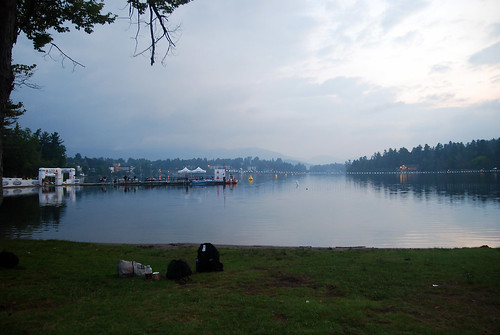 Mirror Lake at 5amThe Swim
Mirror Lake at 5amThe SwimIt had started to rain quite hard just before the swim started, though those of us in wetsuits didn't mind of course. The pros set off at 6:50am and ten minutes later the American anthem had been sung and the gun went for us. I had seeded myself right near the buoy line (at Lake Placid the swim course is marked by permanent buoys connected by a yellow underwater rope, making staying on course pretty easy) and pretty close to the front. One thing I don't mind is the washing machine bump-and-grind that characterises mass swim starts; as an ex-club swimmer and lifeling ice hockey player, I generally feel both comfortable and protected in the water. All those bodies moving in the same direction mean extra free speed for me, so bring it on! As it was, I ended up getting on some good feet just inside the buoy line and only came outside of it to go around the corners.
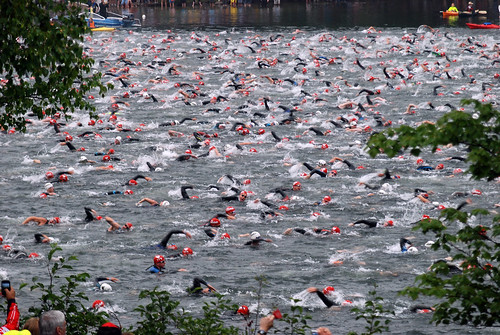 The Washing Machine
The Washing Machine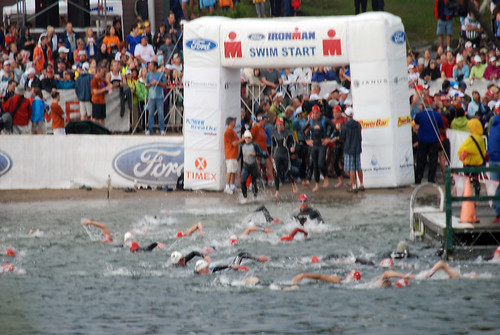 Lap 1 to Lap 2
Lap 1 to Lap 2I had been swimming the course earlier in the week with Jim's
Garmin 305 and thought that the course was a bit long: one lap exactly following the underwater cable was 1960m instead of the 1900m it should be for an Ironman. Not that 60m (120m for the whole course) matters to me, but at least I was prepared for when the clock said 29:28 as I came over the mat, ran across the beach and jumped back in for the second lap. The second lap is always slower just by virtue of fewer people moving in the same direction. So I knew my swim was going to be slower than IM Germany and defintely slower than the sub-60 minutes I'd hoped to go. This wasn't helped by my ridiculous re-entry into the water where I followed some guys the long way around the dock. Regardless, it was a nice swim. My only regret was taking off my swim cap as I ran along with my wetsuit under my arm towards T1. The Garmin was under there, and while I managed to juggle it, the cap, my goggles and earplugs all together, at some point I dropped the Garmin and had to double back to look for it (at a few hundred dollars, I didn't want to lose it, not to mention my data on it!) Thankfully a volunteer saw me looking, took my race number and offered to find it for me so I could carry on. I hoped for the best and made my way to T1.
Swim time: 1:01:58 as 29:28 first lap and 32:30 second lap, 6th AG and 239th overall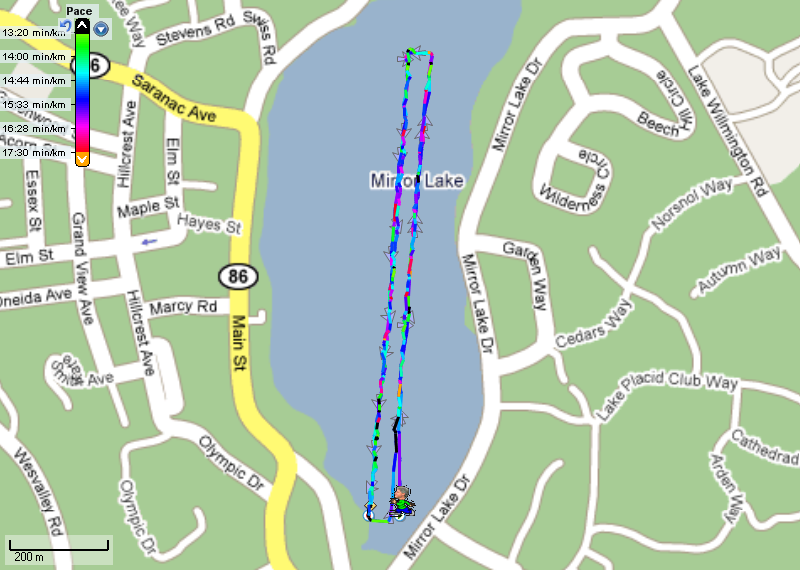 Swim course and speeds
Swim course and speeds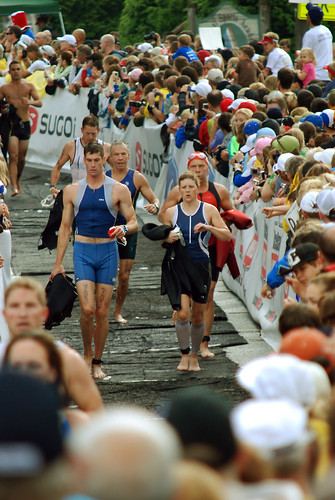 Chute to T1T1 and The Bike
Chute to T1T1 and The BikeA long run up to the Olympic Oval where the bikes were racked, made amazing by the throngs of people lining the chute screaming like crazy. Transition was pretty easy, I grabbed my bag and ran into the tent, threw on my helmet, sunglasses, race belt and shoes and handed my wetsuit and gear back to a volunteer. Since I've discovered
2XU Endurance Tri shorts this year, I've been able to swim, bike and run wearing the same clothes throughout, which makes for quick transitions. My number had been called out on the megaphone but by the time I reached my rack, I was greeted by a poor confused volunteer who sort of looked at me helplessly. I was fortunate that my bike was only three spots from the end of the row, so I just waved at her and smiled and grabbed it myself. She looked relieved and I was on my way, running through the grass in my bike shoes.
T1: 5:13, 4th AG and 177th overall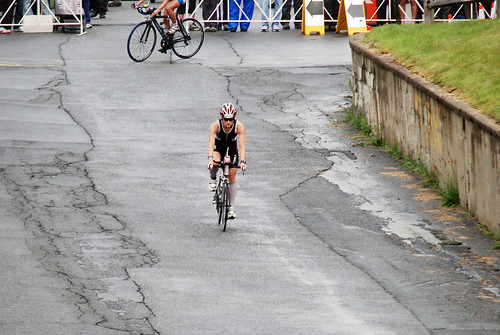 Straight out of T1
Straight out of T1The rain had stopped but the roads were still wet, and with a crazy 180-degree turn followed by a steep downhill straight out of transition then another sharp corner and more downhill, I mounted my bike and rode the first few minutes very gingerly. Once out of town, I settled in and assessed myself. Stomach still not happy, though feeling hungry which I took to be a good sign. Legs however were unaccounted for. Still, not time to panic yet, it's only an hour into the race and I've got at least nine and a half to go! I climbed out of Lake Placid in an easy gear, then ate a bit of my Perpetuem mix before tackling the 7.5km descent into Keene (where I managed to average 54km/h on the first loop and 52km/h on the second -- max was over 70km/h which I know is not super fast, but then again I'm a bit of a lightweight!) The roads were closed to cars which made me feel better than on the day I had practised it, though the winds are tricky through there and my 60mm deep front wheel had ideas of its own about where to go. I kept repeating to myself "you are a good bike handler! this descent is easy!" the whole way down, which seemed to work as I didn't crash like a few unfortunate folks I saw along the way.
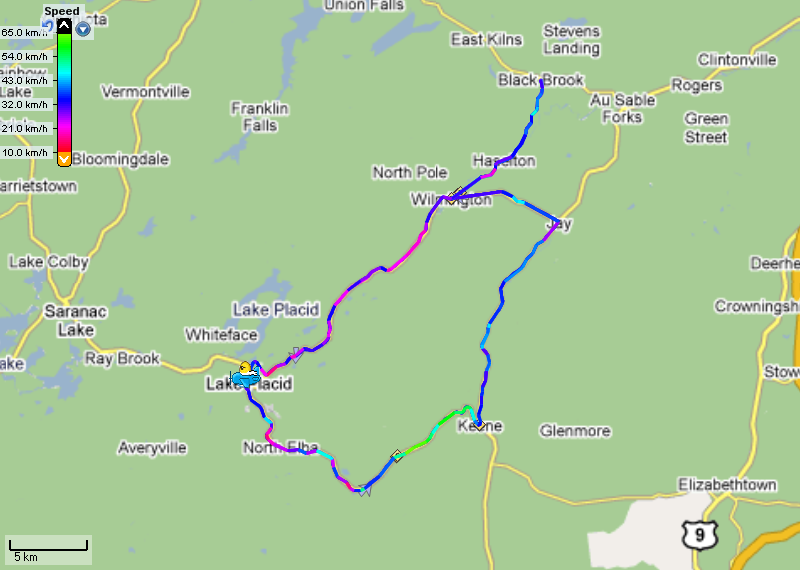 Bike Course and speeds
Bike Course and speedsFrom Keene to Jay was a massive tailwind and given the number of fast guys on the course by then, I was towed along by the draft it seemed. It actually took some effort not to draft as there were just so many bikes along there. Overtaking one person just to hit another's draft zone was frustrating and meant I either had to continuously overtake at least three people a minute (maximum 20 seconds in each person's zone) or pick and choose who I should pass and who I should let sit legally in front of me. Once we hit the hills between Jay and Wilmington, things broke up a bit more, but even so this was a difficult course to ride 100% within the rules. Thankfully I didn't see any huge draft packs and the smaller ones I saw were breaking up regularly due to the hills and aid stations.
 Heading into Wilmington
Heading into WilmingtonJim had left town right after I got through transition, and had ridden the opposite direction on the bike course so he could meet me before the out-and-back section for photos and encouragement. By then -- 45km into the bike leg -- I knew I was going to struggle with my body all day. I felt bloated, blah, head-achy and completely off my game. The average watts I'd planned to push on the bike just didn't happen without an alarming rise in heart rate, so I settled for racing on "feel" while keeping half an eye on heart rate and mostly ignoring the watts on the powertap. In some ways this worked great, as I was able to conserve a lot of energy on the tailwind and downhill sections of the course, yet still climb the hills the way I'm used to -- steady to FTP watts but nowhere near blowing up. In the end my VI was 1.11 for the whole race which I think is quite high. But given my state of disarray on the bike course, going on feel meant surviving on what felt right to me at the time, which meant ups and downs instead of a steady watts ride. I'm still thinking this one over and the truth is that I haven't done enough "bad" long rides and IM races to know whether I did myself a good or bad turn with this strategy. Interestingly enough, my normative watts over the whole course were only about 5-10 watts off from what I'd wanted my average watts to be! All I can say is I hope to ride more steady at Kona.
 A happy moment
A happy moment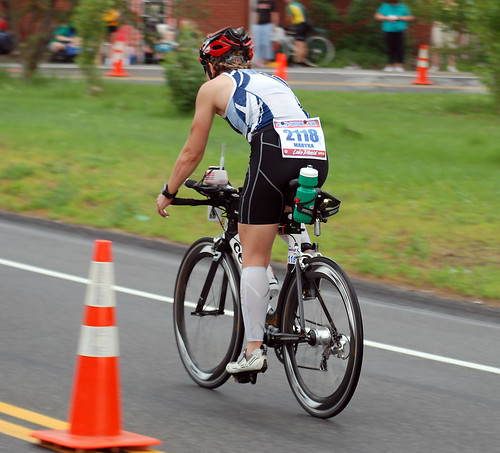 The wheels are in sync even if I'm not
The wheels are in sync even if I'm notSo, plan B then: after burping up my Perp mix a few times, I decided to back off and go with plain water for a while. I knew I had to keep up with my scheduled Endurolytes and Anti-Fatigue caps, but even those were hard to get down. In retrospect, I think I should have had more water early in the bike leg as I probably took in too many calories without enough water to process them. Given that it wasn't really warm on the bike until nearly an hour into it, and that the swim had been in cool water, I thought I didn't need as much water -- and mindful of the multiple times I had to pee during the Stein race, not to mention that I'd already peed twice during the swim -- didn't want to start drinking too much. As it was, I didn't start to need to pee until the second lap (over 3 hours into the bike leg) and didn't stop til nearly 5 hours had gone by. If that wasn't the biggest clue that I was underhydrating.... hard to believe now that I could have been so dumb! It wasn't for lack of aid stations either, it was just me being a newbie. Speaking of aid stations, at the out-and-back I tried to grab a fresh water bottle, but between the right-hand hand-off (I'm left-handed), the size of the bottle and the fact that it was cold and dripping, I managed to drop it not once but twice! Finally the third hand-off worked, but to all the folks riding anywhere near me at that moment, I sincerely apologise for making your day needlessly stressful by having to steer around my dropped bottles. Mea culpa.
 Crowds at the aid station
Crowds at the aid stationAll along I'd been taking split times on the bike and I knew after the end of the out-and-back that I was in pretty good shape timewise for someone who was riding too easy and not having a great day. When I hit Wilmington just after 2 hours on the bike and started the last ~20km back into town to complete the first lap, I knew I was still in the money. Climbing past Whiteface Mountain my legs finally put in their first appearance of the day and I started to feel better all around. The Papa Bear climb was packed with cheering fans, and I got a real call-out for my in-the-aero-bars climbing technique, especially as I passed a dozen guys out of the saddle and grinding their way up the hill.
Into town and passing the crowds, I blew right by Special Needs (the flat tire monsters had thankfully stayed away this year, so there was nothing I needed anyway) and started the second lap. Pretty much the same as the first, though now the course was quite a bit more deserted, the wind had kicked up, the sun was hotter, and the people I did see were looking considerably rougher around the edges. I continued to feel a bit better, tested the waters with some more Perp, then switched to Hammer Gel instead. I attempted to pee on the bike several times between Keene and Wilmington, but as the day was sunny and bone-dry, I just couldn't bring myself to do it. Frustrated by the lost seconds spent coasting and trying to go, I finally gave up and stopped for a minute at the portapotty on the out-and-back.
 Still aero
Still aeroMy stomach and I had seemed to come to a truce: I wouldn't keep trying to overfeed it, and it wouldn't get worse on me (though never truly came around and felt great either). But apparently I'd forgotten to negotiate a deal with my legs because a few kms after leaving Wilmington for the final painful jaunt back into Lake Placid, I got a wicked cramp in my left quad on the inside. Tried to stretch it out and massage it on the bike, but every time I put any power into my pedal stroke it would seize up again, so I finally had to stop by the side of the road and try to fix it. This was particularly frustrating as I had been overtaking lots of people at this point (minus the stops, my split times between first and second lap were pretty good). A guy with a maddeningly squeaky disk wheel and I were trading places on the climbs and descents, and I wanted to cry when I was off my bike stretching and saw --
heard -- him go by.
The muscle cramps got me twice more on the road back to transition, the left leg again and then the right. The final time was just before the last five rollers into town, the Cherries and Bears. I pulled over to the side, right leg unclipped and in agony, thinking "the shoulder's not that wide here, better pull off into the rough so people can get by me" and promptly hit the sand and crashed on my left side, still clipped in, expletives leaving my mouth rather loudly. Some guy rode by and asked if I was all right in that sort of "I'll stop if I have to help you but I really hope you say you're fine" way -- and given the number of ambulances we'd all seen on the course, I can't blame him -- but I waved him on. Took stock of the damage, a scraped knee and big bruise on my thigh where it hit the top tube and felt pretty mad at myself. Which then sort of woke me up and got me going again, I jumped back on my bike and rode the rest of the way into town cramp-free and with fresh resolve to get the suffering over with and start the run. By the time I got through transition, I was in 3rd place in my age group and 263rd overall in the race, 114.4 miles down and only 26.2 more to go.
Bike time: 5:49:49 as 2:50:19 first lap and 2:59:29 second lap, 3rd AG and 333rd overall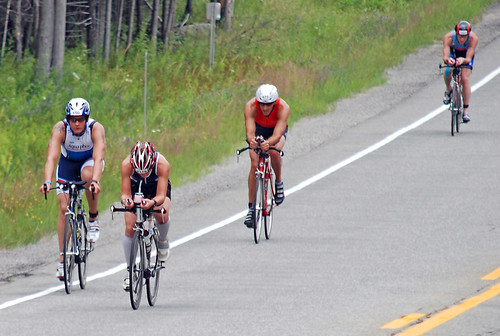 Head down to climb the last hillT2 and The Run
Head down to climb the last hillT2 and The RunThe second transition was quick and painless, with the only interesting moment happening when I dismounted my bike, leaving the shoes on the pedals, and ran -- rather hobbled -- barefoot towards the bag racks wondering how I was going to run a whole marathon when I could barely make it through transition? Socks and shoes on, decided to start with a visor and see how it went (lately I've been finding it cooler to run without any hat), grabbed my packet full of goodies while a volunteer slapped some sunscreen on my shoulders, and then I ran out. The packet contained all the individual Hammer gels I'd prepacked for the run, plus two Hammer coin purse thingies, one for Endurolytes and one for Anti-Fatigue caps, all in a Ziploc bag. I started loading my pockets as I ran out onto the course to save time, then tossed the baggie at the first aid station. Jim had seen me coming in from the bike course and shouted that I was in third place in my age group by only about five minutes or so. Good to know, but at this point I had to focus on running well and pacing carefully or all that holding back on the bike would be for nothing.
T2: 2:22, 2nd AG and 121st overall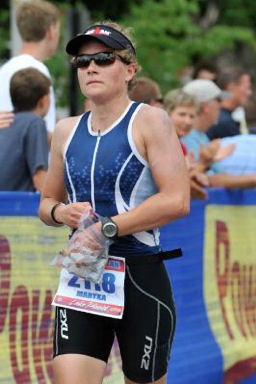 Sorting through the packet
Sorting through the packetMy legs loosened up right away, and I ran the first half mile (albeit all downhill) in only four minutes, which was a bit quick for my plan. I figured I might as well take my first bathroom break to help slow me down a bit. My goal was to run about 5:10/km for the first ten kms -- those splits including all walk breaks at the aid stations -- then try to pick it up a bit or hold steady, depending how I was feeling and knowing that the last six or seven kms of the course with their tough uphills would be the hardest and slowest. I had the Garmin 405 on my wrist so I could keep track of how hard I was going, and it proved to be a great time-manager (and later a whip-cracker) for my pace. I was feeling more or less like my old self again, choking back gels as I needed to and getting my aid station ritual down: dump the old sponges at the start, grab two cups of water (one for my mouth, one over my head), a crushed fresh cup of ice to sit in my trishirt behind my neck, then fresh cold sponges across my chest. Walk just enough to make this all happen, then start running again. I was passing tons of people even in the first lap, as predictably many guys had overcooked the bike leg and were looking at a long day's suffering on the run. Just before I reached the turnaround at 9km, I saw the two women ahead of me in my age group running towards me. I estimated that only about half a mile separated us which put an age group win in reach for me, unless one of them turned out to be a great runner. But as I ran back I spotted the fourth place girl about the same distance behind me. Nothing I could do about it, just had to keep going.
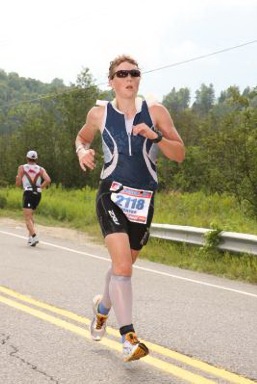 Running the tangents
Running the tangentsUp the hill to town and man did that hurt. People were already walking. At least I knew how long it was and that it flattened out after the corner, so I dug a little and kept running. Through town and onto Mirror Lake drive to complete that cruel race director's joke called the second out-and-back. On the first lap, at least the Special Needs bags are there providing some distraction from the fact that you need to run nearly a mile past the finish line entry point then back again before you can head out of town for the second loop. At the end of the race it's nearly unbearable to have to run past the finish chute
again before you can enter it! Special Needs had only one thing I wanted: a (no longer) frozen bottle of Heed that I'd made up the night before. The sun had come out again and it was getting hot, so I also dumped my visor in the bag. That bottle of Heed tasted like nothing ever has or ever will again -- I grabbed a cup of ice and poured the Heed over top and drank like it was the last drink of my life. Awesome! It lasted until I made the turnaround and ran past the aid station again, where I chucked the empty bottle and ran past the cheering crowds feeling like a million bucks to start the second half of the marathon. Kms 20 and 21, the ones after Special Needs, rang in at 5:00 and 5:05 respectively, keeping my overall pace to that point at 5:15/km. I did feel bad, however, to see the folks still riding in after their second bike lap and who hadn't even started the run!
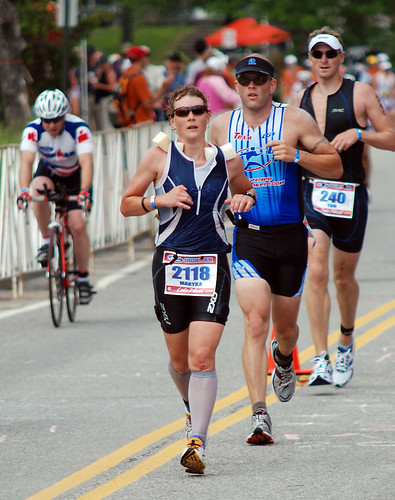 Fleetfooted after Special Needs
Fleetfooted after Special NeedsRunning downhill out of town again, I finally saw the end of of a long day slowly coming into sight. Just had to keep up the relentless forward movement, counting down the miles -- now fewer to go than I had done -- and I would be done with Ironman Lake Placid. The run course was really crowded now as most people had started the marathon, and it was hard to tell who was on the first lap and who was on the second (note to IMLP organisers: little bracelets to hand off after the first lap would help competitors keep track of each other!) The run out River Road to the turnaround was again pretty quiet, though the cramps that had taken me down on the bike were threatening to return again on the run, this time in my calves. My aid stations walks were becoming longer and I had to stop several times to stretch out my calves. I had been running the tangents, saving myself as much distance as possible, but now I wondered if it was better to run slightly longer but in the shade. Midway to the turnaround I saw two women in my age group coming at me and looking quite strong, and in my mentally exhausted state couldn't remember if they were the same women who had been ahead of me all along. If they were, then they had me beat by a fair bit. If not, then where were the women ahead of me? At that point I realised that it was out of my hands either way. I couldn't run any faster without risk of cramping up, and as long as I didn't slow down, I wouldn't lose any places (the 4th place girl who I did recognise in her
Endurance Nation kit was falling behind steadily). So to my great relief, I just gave up caring where anyone else in my age group was and ran on as best I could.
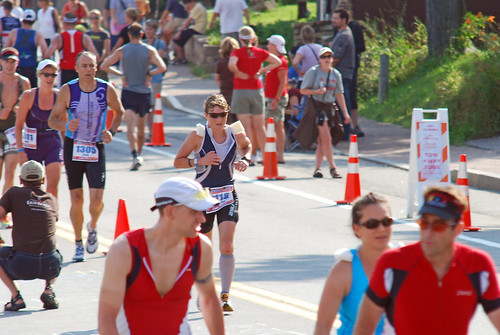 Trying to run, not walk
Trying to run, not walk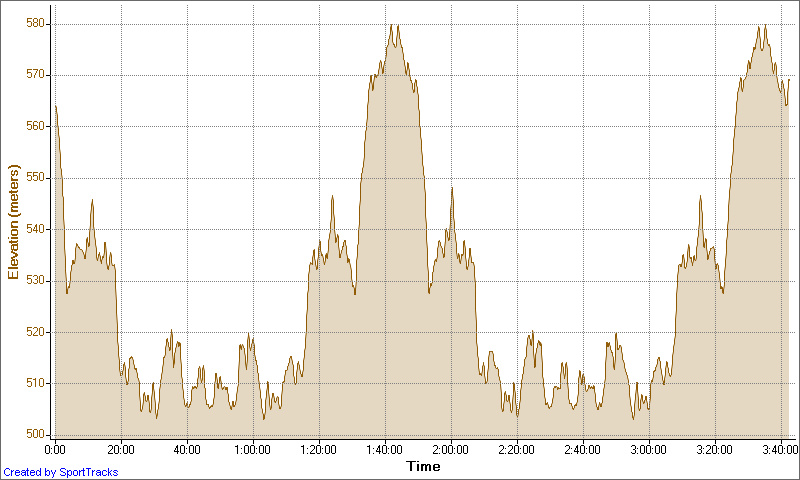 Run Elevation and Gradient
Run Elevation and GradientTurned out that the two women in front of me were fading fast while I was still running 5:17-5:18/km, but I didn't manage to catch them until the final half hour of the race. I barely noticed overtaking them as I was going by tons of people by then, particularly on the hills where many were walking, and the body marking had worn off hours ago. Later, the third place girl would tell me she saw me go by but just couldn't hold my pace. I saw Jim at the top of the hill with less than two miles to go and suddenly had a moment of panic: what if there was some hotshot marathoner who'd been creeping up on me all this time the way I'd crept up on the others? I shouted to Jim "who's behind me?" and he gave me a confused look. "Everyone is! You're in first place!" I shook my head thinking it couldn't be possible, what about those speedy ladies I'd seen before? But no time to argue, I had to keep going but for the first time I allowed myself to think that I might actually win my age group.
Just that awful last out-and-back to do along Mirror Lake, helped immensely by the thronging masses cheering me along for actually still running at a reasonable pace, then I was done. I made sure to toss my sponges and ice at the aid station to make myself presentable for the finisher's photos, and Jim (where did he come from? must have hoofed it up that hill double time!) shouted to smile when I crossed the line. Then into the Olympic Oval and half a lap around before running under that magical Ironman banner. I reminded myself that this could be the last race I ever do -- after all, you never know what could happen in the future -- which did indeed bring a grin to my face, and with a sort of gay fist pump I ran across the line. In the end I ran the fastest marathon in my age group.
Run time: 3:42:31 as 1:49:16 first lap and 1:53:15 second lap, 1st AG and 131st overall Fist Pump!
Fist Pump!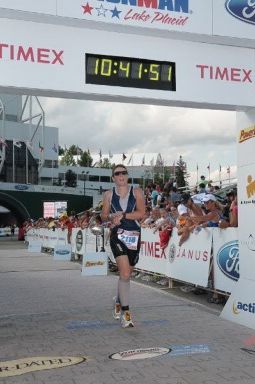 Across the finish lineThe Aftermath
Across the finish lineThe AftermathDespite aching legs, I actually felt pretty good when the race was over. Mike Reilly had called out my name when I finished, but no mention was made of what place I was in my age group so I still wasn't quite sure I had won. I grabbed some food then got my dry clothes bag and took off my wet shoes, socks and calf guards. Found Jim and chatted briefly, then went to get my scraped knee bandaged and a massage before my muscles completely seized up on me. The medical tent was full of rough-looking folks --only 152 people out of 2250 had finished in front of me and half of them were in that tent! But given the number of ambulances carting people from the run course I wasn't really surprised. As much as I wondered how good it would be to get an IV, I knew I didn't need it, so I got changed into my compression tights and went out to take care of some lingering business: checking out the results and tracking down the lost Garmin!
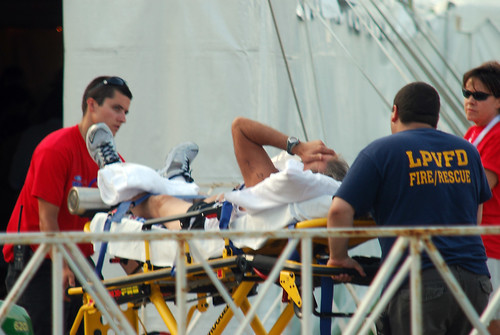 Thankfully I didn't need one of these!
Thankfully I didn't need one of these!Seeing my name listed as first in my age group, it finally sunk it that I had won! I immediately felt a sense of guilt, as I had had such a bad day that I almost didn't believe I deserved it. Still, upon checking out the bike and run times, I realised it was my months of training and my race execution on the day that got me through it, and not how good or bad I felt during the race. Staying cool-headed and trusting myself rather than panicking or giving up was the key to getting through the tough moments. So in that sense, it was one of the most deserved victories I've ever had. And ultimately, if I had to choose between an awesome day with a lesser result, and a tough day with a great result, I'd pick the latter every time. :)
Total race: 10:41:52 as 1:01:58 swim, 5:49:49 bike and 3:42:31 run, for 1st AG, 16th woman and 153rd overall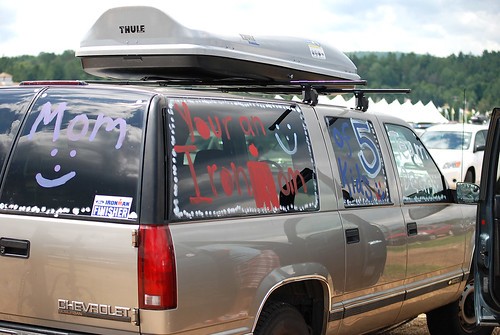 Ironman Mom
Ironman MomThe Kona rolldown was at 9am sharp the following day (we were nearly first in line) and then it was the awards banquet. Mike Reilly gave an update on the last finishers of the night and played the poignant pros, volunteers and finishers videos. Then we were presented with our trophies (little M-Dot plaques in graduating sizes) and called up by age group to the stage for photos and applause. Though it looks like we were standing in order of height, that's actually the order than we finished!
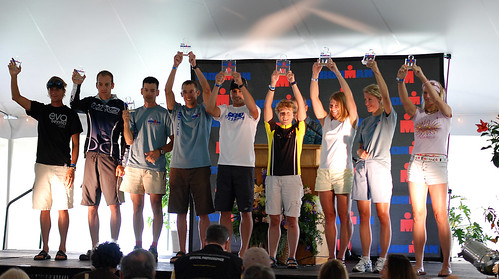 Male and Female 35-39 Podium
Male and Female 35-39 PodiumLater that evening my five housemates and I went out for a group celebration dinner, with plenty to celebrate as both Jeremiah and Esther had completed their first Ironmans with excellent results. Bob had enjoyed his time volunteering (and drinking beer for a change while in Lake Placid for race week, as he'd previously done the race several times himself as a competitor). Our loyal supporters Jim and Armando stuck it out the whole day despite the rain, the sun, the crowds and the long hours standing around wondering where we were. So a success all around and a great time had in Lake Placid.
 The gang from 4 Cherokee TrailAll pics by Jim except for a few from the official race photo guys which I'm planning to purchase shortly. Epilogue
The gang from 4 Cherokee TrailAll pics by Jim except for a few from the official race photo guys which I'm planning to purchase shortly. EpilogueSome bike power data for those who like that kind of stuff:
Lap 1:
Duration: 2:50:19 (2:50:21)
Work: 1515 kJ
TSS: 137.5 (intensity factor 0.696)
Norm Power: 164
VI: 1.1
Pw:HR: -11.49%
Pa:HR: 12.33%
Distance: 89.771 km
Elevation Gain: 2598 m
Elevation Loss: 2591 m
Grade: 0.0 % (6 m)
Min Max Avg
Power: 0 344 148 watts
Heart Rate: 102 169 150 bpm
Cadence: 47 166 91 rpm
Speed: 0 75.8 31.6 kph
Pace 0:47 0:00 1:54 min/km
Altitude: 195 672 395 m
Crank Torque: 0 57.6 15.6 N-m
Lap 2:
Duration: 2:59:29 (2:59:30)
Work: 1587 kJ
TSS: 147 (intensity factor 0.701)
Norm Power: 165
VI: 1.12
Pw:HR: -2.99%
Pa:HR: 23.89%
Distance: 90.3 km
Elevation Gain: 2597 m
Elevation Loss: 2606 m
Grade: -0.0 % (-10 m)
Min Max Avg
Power: 0 394 147 watts
Heart Rate: 104 170 154 bpm
Cadence: 30 166 90 rpm
Speed: 0 93.5 30.2 kph
Pace 0:39 0:00 1:59 min/km
Altitude: 195 672 396 m
Crank Torque: 0 66.8 15.8 N-m
Entire workout (30.9 kph):
Duration: 5:49:49 (5:49:52)
Work: 3102 kJ
TSS: 284.4 (intensity factor 0.698)
Norm Power: 164
VI: 1.11
Pw:HR: 2.62%
Pa:HR: 7.25%
Distance: 180.083 km
Elevation Gain: 5194 m
Elevation Loss: 5198 m
Grade: -0.0 % (-4 m)
Min Max Avg
Power: 0 394 148 watts
Heart Rate: 102 170 152 bpm
Cadence: 30 166 91 rpm
Speed: 0 93.5 30.9 kph
Pace 0:39 0:00 1:57 min/km
Altitude: 195 672 396 m
Crank Torque: 0 66.8 15.7 N-m
And run data too:
Lap 1:
Duration: 1:49:15
rTSS: 126.8 (0.788)
NGP: 5:05 (196.8 m/min)
Pa:HR: 7.29%
Distance: 20.719 km
Elevation Gain: 418 m
Elevation Loss: 408 m
Grade: 0.0 % (9 m)
Min Max Avg
Heart Rate: 91 162 145 bpm
Speed: 0 16.7 11.4 kph
Pace 3:36 0:00 5:17 min/km
Altitude: 504 583 530 m
Lap 2:
Duration: 1:53:25
rTSS: 128.1 (0.781)
NGP: 5:09 (194.0 m/min)
Pa:HR: 2.5%
Distance: 21.354 km
Elevation Gain: 442 m
Elevation Loss: 451 m
Grade: -0.0 % (-9 m)
Min Max Avg
Heart Rate: 104 161 151 bpm
Speed: 0 22.5 11.2 kph
Pace 2:40 0:00 5:22 min/km
Altitude: 504 583 531 m
Entire workout (149 bpm):
Duration: 3:42:40
rTSS: 259.5 (0.785)
NGP: 5:07 (195.5 m/min)
Pa:HR: 4.98%
Distance: 42.073 km
Elevation Gain: 860 m
Elevation Loss: 860 m
Grade: 0.0 % (1 m)
Min Max Avg
Heart Rate: 91 162 148 bpm
Speed: 0 22.5 11.3 kph
Pace 2:40 0:00 5:19 min/km
Altitude: 504 583 531 m
